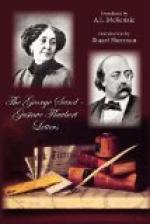“The only way not to be unhappy is to shut yourself up in art, and count everything else as nothing. Pride takes the place of all beside when it is established on a large basis. Work! God wills it. That, it seems to me, is clear.
“I am reading over again the Aeneid, certain verses of which I repeat to myself to satiety. There are phrases there which stay in one’s head, by which I find myself beset, as with those musical airs which are forever returning, and cause you pain, you love them so much. I observe that I no longer laugh much, and am no longer depressed. I am ripe, you talk of my serenity, and envy me. It may well surprise you. Sick, irritated, the prey a thousand times a day of cruel pain, I continue my labour like a true working-man, who, with sleeves turned up, in the sweat of his brow, beats away at his anvil, never troubling himself whether it rains or blows, for hail or thunder. I was not like that formerly.”
The half-dozen works which Flaubert beat out on his “anvil,” with an average expenditure of half-a-dozen years to each, were composed on a theory of which the prime distinguishing feature was the great doctrine of “impersonality.” George Sand’s fluent improvisations ordinarily originated, as we have noted, in an impulse of her lyrical idealism; she began with an aspiration of her heart, to execute which she invented characters and plot so that she is always on the inside of her story. According to Flaubert’s theory, the novel should originate in a desire to present a certain segment of observed life. The author is to take and rigorously maintain a position outside his work. The organ with which he collects his materials is not his heart but his eyes, supplemented by the other senses. Life, so far as the scientific observer can be sure of it, and so far as the artist can control it for representation, is a picture or series of pictures, a dramatic scene or a concatenation of dramatic scenes. Let the novelist first, therefore, with scrupulous fidelity and with minute regard for the possible significance of every observable detail, fill his notebooks, amass his materials, master his subject. After Flaubert, a first-rate sociological investigator is three-fourths of a novelist. The rest of the task is to arrange and set forth these facts so that they shall tell the truth about life impressively, in scene and dramatic spectacle, the meaning of which shall be implicit in the plot and shall reach the reader’s consciousness through his senses.
Critics have spent much time in discussing the conflict of “romantic” and “realistic” tendencies in Flaubert’s works. And it is obviously easy, so far as subject-matter is concerned, to group his books in two divisions: on the one hand, The Temptation of St. Anthony, Salammbo, and two of the Trois Contes; on the other hand, Madame Bovary, L’Education Sentimentale, and the incomplete Bouvard and Pecuchet. We may call the tales in the first group romantic, because the subject-matter




